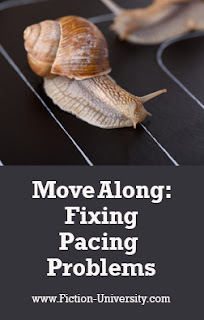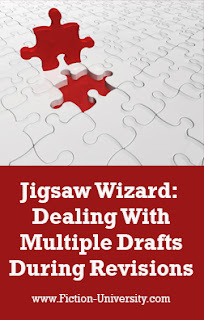Janice Hardy's Blog, page 12
February 16, 2023
How to Find Your Readers
 By Jenna Harte
By Jenna Harte
Part of The Indie Author Series
JH: It's hard to sell a book if you don't know who you're selling it to. Jenna Harte shares tips on identifying and then finding your reading audience.
I wrote an article for Fiction University on Selling More Books with Marketing Mind Shift in which I suggested authors think less about selling a single book through a Tweet, and instead about building a community of avid readers. The article explained how to do that, with one exception; how do you find your audience? This piece is a follow up to that article to provide tips and resources on finding your readers and creating a community for them.
Continue ReadingWritten by Janice Hardy. Fiction-University.com
Published on February 16, 2023 05:05
February 13, 2023
There is No Bad Guy: What to do When Your Antagonist Isn't a Villain
 By Janice Hardy. @Janice_Hardy
By Janice Hardy. @Janice_Hardy
All stories need an antagonist, but not all stories have a villain.
The word antagonist usually conjures an image of a "bad guy," but that's not always the case. The antagonist in a story is simply the opposition to whatever the protagonist is trying to accomplish.
A mother trying her best to stop a willful child from going down a destructive path is the antagonist to that child, same as a terrible storm is an antagonist to a hiker trying to reach safety on a mountain.
An antagonist can come from any of the four basic conflict types, and they each focus on a different type of conflict opposition. We've discussed the person vs. self antagonists, and person vs. nature conflicts, so let's continue with the person vs. society conflicts.
Continue ReadingWritten by Janice Hardy. Fiction-University.com
Published on February 13, 2023 03:00
February 6, 2023
Move Along: Fixing Pacing Problems
 By Janice Hardy, @Janice_Hardy
By Janice Hardy, @Janice_Hardy
A badly paced novel can ruin an otherwise strong story.
Pacing problems fall into two categories: too slow or too fast. While this makes it easy to diagnose the trouble, it takes a bit more to solve the actual problem. Too slow can be an editing issue, a stakes issue, or even a structure issue. Too fast can be a plotting problem, a characterization problem, or yes, a structure problem.
If your pacing isn’t where you want it to be, first identify what the problem is.
Is your pacing too slow?
While any number of things can contribute to a slow pace, "too much of something" is usually the culprit. Maybe it has too many long sentences, or it's heavy exposition, or characters give too many speeches. A reader has to slug through "a lot of something" to get to the actual story.
Continue ReadingWritten by Janice Hardy. Fiction-University.com
Published on February 06, 2023 03:00
January 30, 2023
5 Ways to Raise the Stakes in Your Scene
 By Janice Hardy, @Janice_Hardy
By Janice Hardy, @Janice_Hardy The worse things get for your character, the better it is for your reader.
I love doing terrible things to my characters. I’m a firm believer that whatever doesn’t kill them makes them more interesting. But even I sometimes forget to raise the stakes—or even have stakes—in a scene.
I get distracted by the plot, or a world building detail that needs to fit in somehow, or I get caught up in a fun conversation between characters and lose myself in their banter. Anything could cause me to forget to add the stakes, because there’s so much that goes into every scene, it’s easy to miss an important element.
But when that element is a core part of keeping readers hooked in the story, it risks ruining a perfectly good scene.
Continue ReadingWritten by Janice Hardy. Fiction-University.com
Published on January 30, 2023 05:20
January 23, 2023
How a Sequel Works with a Scene
 By Janice Hardy, @Janice_Hardy
By Janice Hardy, @Janice_Hardy Sequels are the emotional glue holding scenes together.
Before I dive it, I’m over at The Insecure Writer’s Support Group today, chatting about the dangers of empty dialogue. Come on over and check it out!
Now, on to today’s regularly scheduled post…
The sequel trips up a lot of writers, even when they know what it is. The most common problem is thinking it has the same nature (and structure) as a scene, so they try to write it as one.
And it fails.
The pacing flatlines, there’s no goal, and often, writers twist themselves into knots trying to add a goal, motivation, and conflict to a sequel, trying to “make it work.”
Continue ReadingWritten by Janice Hardy. Fiction-University.com
Published on January 23, 2023 03:00
January 16, 2023
7 Reasons Why Your First Draft Sucks
 By Janice Hardy, @Janice_Hardy
By Janice Hardy, @Janice_Hardy First drafts are written first for a reason.
Getting to the end of a first draft is an accomplishment that ought to be celebrated, no matter what state that draft is in. It takes a lot of effort and determination to write an entire novel. It takes planning and brainstorming, and uses up a ton of creative juice to get all those ideas from our heads to the page.
It’s also not uncommon to stumble a bit and write a first draft that’s, shall we say, less than stellar. Maybe it even sucks.
If this is you, take heart—you’re not alone.
Bad first drafts happen all the time, even to professional authors with dozens of books under their writing belts. Writing is a creative endeavor and you can’t force creativity, even if you can plow through it and keep writing when the muse is on vacation.
Continue ReadingWritten by Janice Hardy. Fiction-University.com
Published on January 16, 2023 04:22
January 9, 2023
The Difference Between Setting and World Building
 By Janice Hardy, @Janice_Hardy
By Janice Hardy, @Janice_HardyYour novel’s world will change the look and feel of every setting in that world.
Where is your novel set? It’s a basic question every writer can answer, either with a simple location or a description. For example, it’s set in New York vs. it’s set in an alternative Atlanta where magic and technology battle in waves over which one has control.
But look closer at those answers. One is a location, the other is a world.
“New York” can exist in any novel set in a big city. It gives readers a general sense of where the story takes place and what it looks like, but there’s a huge difference between New York in 1763 and New York in 2023.
“Alternative Atlanta” gives you a world that suggests far more than a basic setting for a story. Magic and technology, battling for control, which naturally leads to imagining the kind of people who live here and the problems they might face. It even says what genre this is. (For the curious, this is the world of Kate Daniels in Ilona Andrews’ urban fantasy series)
Continue ReadingWritten by Janice Hardy. Fiction-University.com
Published on January 09, 2023 03:28
January 2, 2023
The 2022 Wrap Up: What Are Your Goals for 2023?
 By Janice Hardy, @Janice_Hardy
By Janice Hardy, @Janice_HardyIt’s a new year, and time to take a look back on what we accomplished, and set new goals for 2023.
Happy New Year, everyone!
I hope you had a wonderful holiday season and are starting off 2023 with new vigor and purpose.
As for me, well, I feel kinda bad for 2023. I have such expectations for it. It’s unfair of me to put so much pressure on it to be a better year than 2022 (or let’s be honest here—better than the past five years), but I’m doing it anyway. I’m ready for more positivity and optimism in my life, and I’m hoping this new year will arrive with some.
I didn’t do a wrap up or goal list last year, so I went back to 2021 to see what my goals and accomplishments were. It was interesting to see where I was as 2020 rolled into 2021. It started off well until July, when life imploded health-wise for me and my husband.
Continue ReadingWritten by Janice Hardy. Fiction-University.com
Published on January 02, 2023 05:53
December 12, 2022
Dealing with Multiple Drafts During Revisions
 By Janice Hardy, @Janice_Hardy
By Janice Hardy, @Janice_HardyDuring a revision, trying to piece together all the best parts of your novel and still make the story feel cohesive can be a challenge.
Some novels are really hard to revise. The story goes through multiple drafts and there are strong scenes in each one—but no one draft that works on its own. The only way to save the story and craft the novel you know you have in there somewhere, is to pick the best scenes and smoosh it all together.
Which can be good, or lead to a Frankendraft.
Don't fret though—you can turn all those drafts into a novel worth reading. It just takes a little more work and a lot more focus.
When dealing with multiple drafts of a novel, the first step is to clarify what you have that works, and what you have that doesn't.
Make a list of your scenes allows you to identify which pieces contribute to your core conflict and which don't. Note the critical details in all the scenes you plan to use and see how they flow together. Maybe even craft a one-line summary of each scene that describes the plot movement so you can see how they connect to the overall story arcs.Continue ReadingWritten by Janice Hardy. Fiction-University.com
Published on December 12, 2022 05:16
Jigsaw Wizard: Dealing with Multiple Drafts During Revisions
 By Janice Hardy, @Janice_Hardy
By Janice Hardy, @Janice_HardyDuring a revision, trying to piece together all the best parts of your novel and still make the story feel cohesive can be a challenge.
Some novels are really hard to revise. The story goes through multiple drafts and there are strong scenes in each one—but no one draft that works on its own. The only way to save the story and craft the novel you know you have in there somewhere, is to pick the best scenes and smoosh it all together.
Which can be good, or lead to a Frankendraft.
Don't fret though—you can turn all those drafts into a novel worth reading. It just takes a little more work and a lot more focus.
When dealing with multiple drafts of a novel, the first step is to clarify what you have that works, and what you have that doesn't.
Make a list of your scenes allows you to identify which pieces contribute to your core conflict and which don't. Note the critical details in all the scenes you plan to use and see how they flow together. Maybe even craft a one-line summary of each scene that describes the plot movement so you can see how they connect to the overall story arcs.Continue ReadingWritten by Janice Hardy. Fiction-University.com
Published on December 12, 2022 05:16



